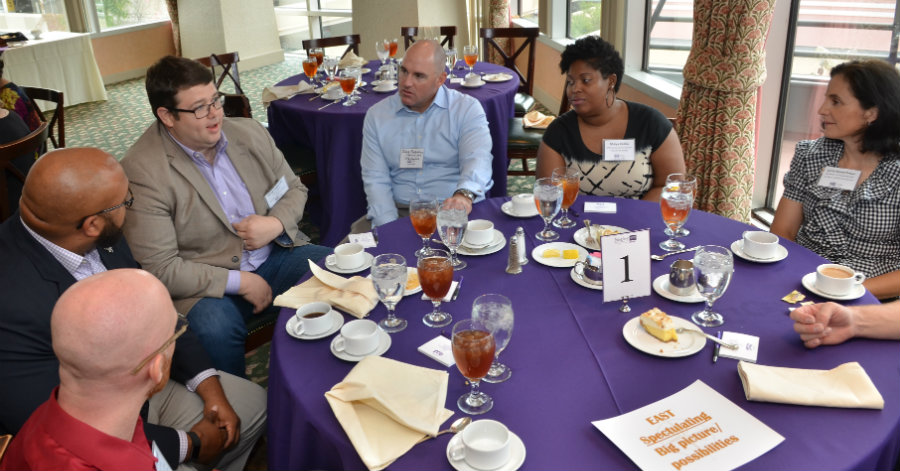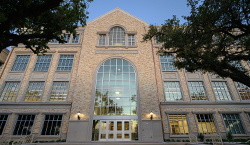Leadership development is a core component of the Neeley Executive MBA program – but can you really learn leadership? Isn’t it just something you are either good at or not?
Dr. Linda LaCoste, Director of EMBA Student Services and Operations and faculty for the personal leadership development process at Neeley, explains: “Leadership development isn’t a course in the program: It’s baked into every course.” As a student, you become the facilitator, while Neeley provides content and experiences that let you hone your skills.
July 06, 2017
Leadership development is a core component of the Neeley Executive MBA program – but can you really learn leadership? Isn’t it just something you are either good at or not?
Dr. Linda LaCoste, Director of EMBA Student Services and Operations and faculty for the personal leadership development process at Neeley, explains: “Leadership development isn’t a course in the program: It’s baked into every course.” As a student, you become the facilitator, while Neeley provides content and experiences that let you hone your skills.
An Eye-Opening Exercise
Dr. LaCoste gave us a brief example at the June Preview Luncheon at City Club of Fort Worth, asking everyone to sort themselves into four different personality groups:
- North – The action-oriented people, who’d rather just get started than go over details. The “fidget spinner” people.
- West – The logistical people, who want all the details and plenty of time to analyze them.
- South – The caring people, who want to build a rapport with their team. The “can’t we all just get along?” people.
- East – The big-picture people, innovators who love coming up with big ideas.
Once we were all settled in with the groups we most identified with, Dr. LaCoste asked us to answer four questions as a group:
- What are your personality type’s greatest strengths?
- What are your greatest weaknesses?
- Which other type is most difficult for you to work with?
- What do the other types need to know to help you work more efficiently?
We talked amongst ourselves awhile, making notes of our collective answers, nodding and chuckling at how easily we related to each other. Then Dr. LaCoste asked each group to share one of their answers:
- North said their strengths were: Getting things done, time management, focus and agility.
- West said their weaknesses were: Perfectionism, and spending too much time on the details.
- South said their most difficult group to work with was: West – “They are too focused on the details and tend to take advantage of our easygoing personalities.” (Interestingly, West also named South as their most difficult group: West sees South’s social pleasantries as an interruption to work).
- East said other groups could help them this way: “If you shoot down our idea, give us a reason why. And if you don’t have a better plan, just stick with ours."
It was just a quick exercise, but it illustrated a powerful lesson: Great leaders not only understand their own strengths and weaknesses; they know how to identify strengths and weaknesses in their teams – and by extension, to leverage all kinds of strengths.
Beyond Personality
Of course, the self-awareness and people agility demonstrated in the exercise are just two parts of the comprehensive leadership development process at Neeley. In total, Neeley focuses on 25 leadership competencies identified in our partnership with Korn Ferry International – leading experts in executive development. Korn Ferry assessed more than one million executives across the world, and identified the leadership styles of the top 20 percent of performers. Out of the competencies Korn Ferry uncovered, Neeley identified the 25 that were most relevant to our executive graduates.
Dr. LaCoste explained how the program goes in-depth with those competencies. Before students even attend the introductory in-residence seminar, they take a variety of assessments including:
- Meyers-Briggs Type Indicator, a detailed, well-respected personality test (your spouse is invited to take this as well).
- Voices 360 Assessment, which surveys your peers, direct reports, boss and even clients to rate you on a select group of competencies.
- Strength Deployment Indicator – Shows your motivation as a team member when things are going well versus when you are under stress.
These assessments provide a detailed baseline for where you stand and where you need growth. Afterwards, the entire program acts like an incubator for you to learn how to leverage your strengths and overcome your weaknesses. This happens in many ways throughout the program, but here are the top three:
- Leadership Coaching – Neeley partners with seven top-notch leadership coaches, who work one-on-one with you throughout the program. Using your assessments, your coach helps you choose three competencies to focus on and helps you develop action items. Many of our alumni also stay in touch with their coaches after graduation.
- Teams – Every six months of the program, you’ll be grouped with a different team of classmates to work on assignments together. At the end of each six months, you’ll get evaluations from your team, so you can identify specific strengths and weaknesses and implement improvements with your next team – which means over the 18 months, you’ll have three levels of increasing effectiveness as a leader.
- Personal Leadership Brand – Though the same set of competencies is important for everyone, Neeley doesn’t force you into a box with everyone else. In the Leadership Journey Workshop, you’ll map out your unique brand of leadership – that special combination of talents that sets you apart and makes you most effective as a leader. That brand map becomes a handy guide you can use to continue growing as a leader beyond the program.
Did you find this illuminating? Read more from our leadership experts:

